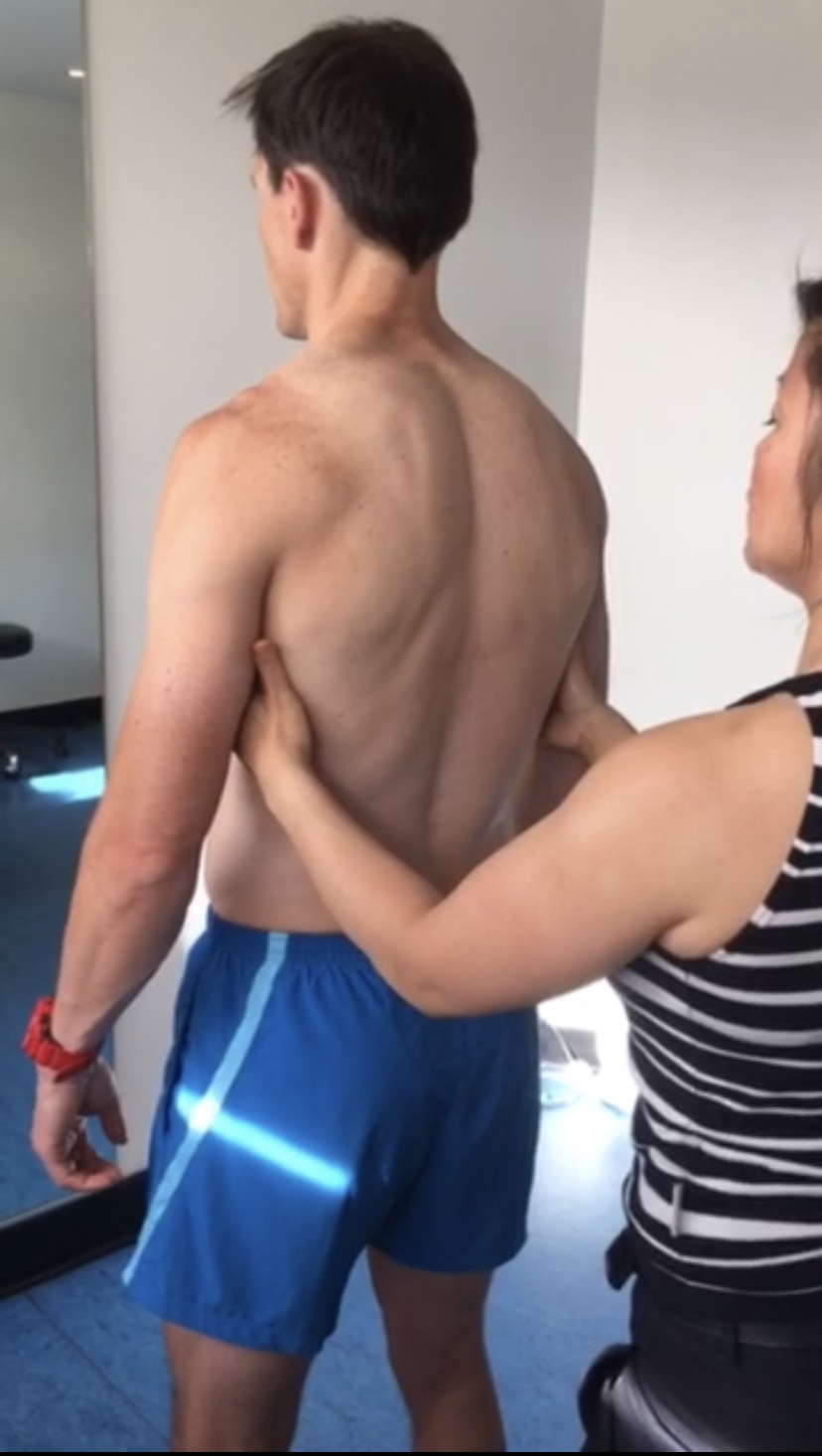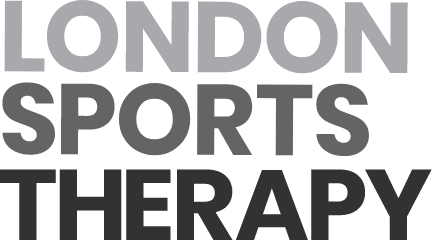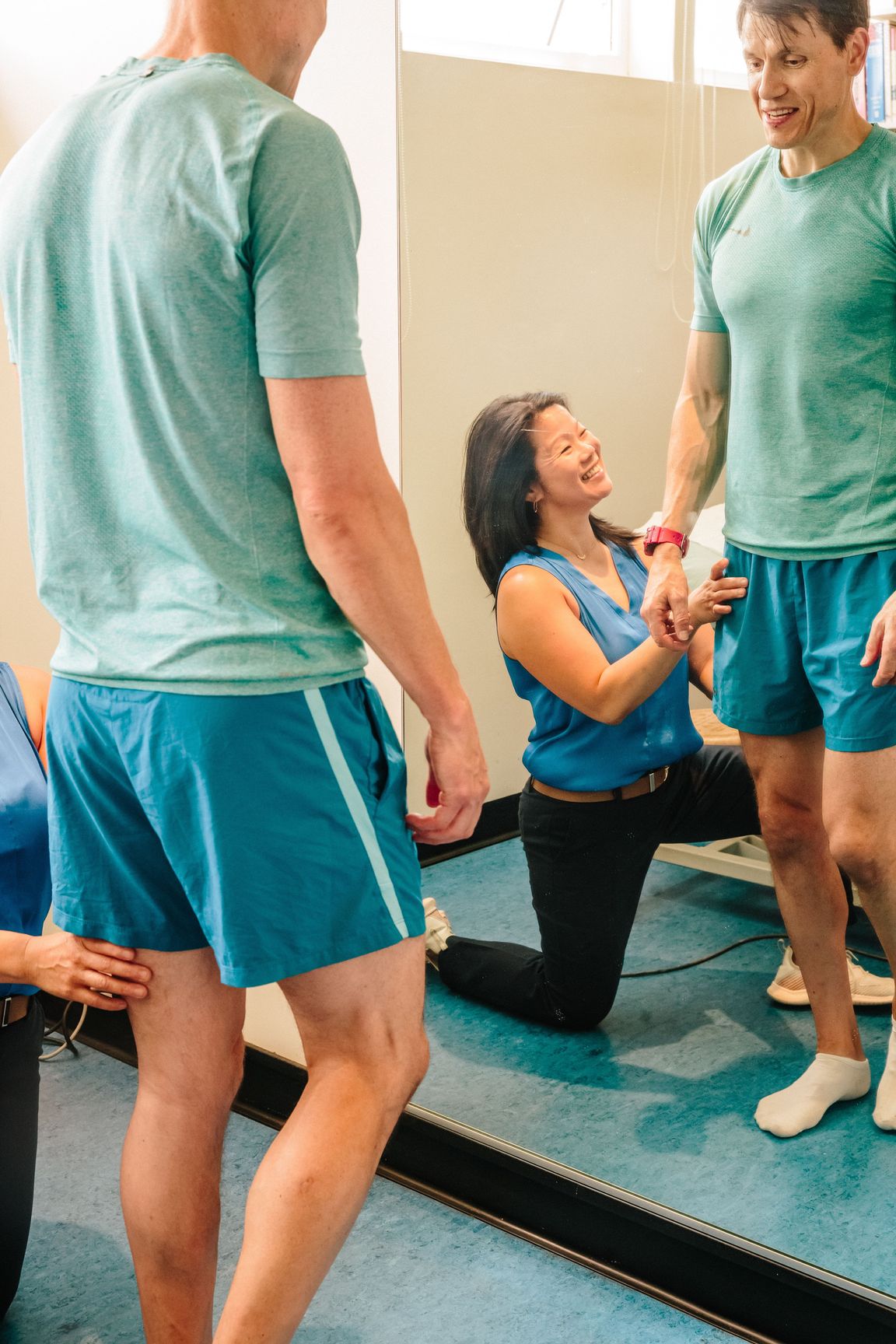I recently shared my marathon experience where I talked about how a calf injury affected my training. To expand on that, I’d like to explain how old injuries can affect your joints and the way you move and why it’s important to address them and never ignore them.
Our holistic approach and functional assessment
When people come and see us at the clinic, we always start with a functional assessment. Trained in Connect Therapy (a relatively new approach in physiotherapy created by Canadian Dr. Linda-Joy Lee), I use a holistic approach. This means we look at how the whole body moves.
When you come to see us with an injury, a niggle, or pain in one or more areas of your body, we take the time to ask you a series of questions to try and understand your story. We consider your whole lifestyle – not just what you do at the gym or when it comes to sports. We watch how your body moves as a whole.
How joints work
Why do we consider how your whole body moves? Because our joints have three planes of motion – meaning they move in three different ways:
- Forward and backward.
- Side-to-side.
- And twisting.
Every exercise we perform at the gym or in the sports we practise can be related back to movements that we do in real life. However, without paying close and intentional attention to the movements we choose to do, we can end up using some planes more than others. This can lead to tightness and restrictions in the body, which then force our bodies to overcompensate.
So if an area of the body is tight or restricted, the body will find another path – the path of least resistance. It will use other joints or muscles to perform movements that other areas should be (ideally) responsible for.
For example, when our hamstrings and glutes are weak, our quads and calves do most of the work when we walk or run. That leads to tightness in these muscles and if the issue isn’t addressed, it can leave us exposed to injuries.
How old injuries can create imbalances in the body
However, scars and old injuries can also play a big part in creating imbalances in the body. And these imbalances can in turn create problems that show up elsewhere.
As surprising as this may sound, your right wrist pain could be a result of a twisted left ankle! An old twisted ankle that healed on its own without treatment or rehab at the time could affect the mobility of your knee, your hip, and other joints.
Ankles, hips, shoulders, and neck are referred to as torque converters. When they are compromised (for whatever reason), the rotational forces have to be displaced elsewhere. This then creates stress in other joints and can cause pain or injury.
We see this often with people who practise sports, and in particular multi-directional sports that rely heavily on the stability of your joints (including your wrists). Typically, these are the sports where these imbalances might make themselves known the most:
- Olympic weight lifting (and specifically any exercise performed with a barbell).
- Running.
- CrossFit (see exercises such as pull-ups, kipping pull-ups, muscle-ups, pistol squats, or gymnastic-related movements, for example).
- Golf.
- Tennis.
Old injuries like fractures can also impact the alignment of bones, depending on how they heal. When bones heal a certain way after a fracture, your mobility could be affected as a result. And a lot of the time there’s nothing that can be done to ‘fix’ that, so to speak. What’s key is to learn ways to work around any restrictions in your mobility.
How old scars affect the mobility of your joints
Wrist, elbow, and shoulder mobility may easily be affected not just by old injuries but by scar tissue as well. Any type of surgery (whether elective or emergency/life-saving) can leave scar tissues behind. Think C-sections, appendix removal, breast surgery, tummy tuck, etc. And scar tissue can affect the way you move through your body.
Essentially, when scar tissue and adhesions are present, to avoid engaging the area affected, the body finds a different path to keep working. But that doesn’t necessarily mean your muscles or joints are then moving at their optimum. The restrictions in certain areas can overload other muscles or joints, creating imbalances that can lead to persistent pain or injuries. We often see in our clinic how anyone who has had a tummy tuck, for example, may experience tightness in their back. This is due to scar tissue affecting the fascia around the ribcage.
How to ‘release’ scars
If you have scar tissue, we recommend you find a good myofascial therapist to help you release your scars. Or you can learn how to release them yourself. There are specific techniques worth learning to help you release scar tissues and any adhesions in the areas affected. This improves the blood supply to the area and stimulates the affected parts of the body to engage again.

Why is it important to be aware of any restrictions of movement?
Being aware of your own restrictions and imbalances can help you modify and adjust your exercise and activity, so you can continue without pain and also not lose the enjoyment of it.
For example, once we’ve assessed you and understood the source or reason why your body moves in a certain way, we can advise your PT or coach. This allows you to adapt your exercises so you can continue training and get results – all while avoiding pain and injuries.
There is always a way to work out around the way you move – even when you can’t directly change some of the physical restrictions in your body. For us at the clinic, the main aim is to get you back to your activities but with modified exercises that will work for you and your body. With running, for example, we can analyse and assess your gait and work around any injuries or restrictions of movement you might have.
Holistic assessment and the way we work
In order to accommodate our holistic way of assessing, we tend to have longer appointments of 50 minutes with our patients. This means we’ll first spend some time with you having a conversation about your symptoms or any pain, injuries, or issues you might be experiencing or need advice on.
Based on the information you give us and the symptoms you display, we form theories and go through a process of elimination by testing these theories through treatment.
As an example, restrictions in your back might cause issues with your hamstring or your calves. Through our assessment, we work out the primary driver to your problem – the actual cause. And this allows us to see what improves your shoulder pain in your squat snatch, for instance.
We have the expertise, the training, and the experience to do that, which is something that unfortunately not all physiotherapists are able to offer. Also, not everyone is in a position to be able to provide face-to-face or hands-on treatment to their clients. So before you visit a physiotherapist, make sure they are able to meet your needs.
Is your clinic just for sportspeople and professional athletes?
Not at all. Our clinic is for everyone, and anyone can benefit from treatment. We all move. At a minimum, we all walk and go about our daily lives. And most of us happen to have minor injuries or scar-inducing surgeries throughout life – with some being more serious and with greater impact than others.
Think about professional athletes. They have regular physiotherapy and treatment to ensure they can continue to play injury-free and perform at the highest level. Amateur or recreational athletes, sports enthusiasts, and people whose jobs or hobbies have nothing to do with sports don’t have that.
But that doesn’t mean we don’t all need it. We see people of all ages, fitness abilities, and backgrounds at the clinic – people who might have been suffering from aches, pain, or even injuries for way too long and without getting the necessary treatment. When you think about it, we regularly spend money on our cars to make sure they continue to work and don’t run into problems. Why can’t we do the same for our bodies?
Essentially, our clinic is for everyone who moves. We have a lot of elderly clients who come to see us pre- or post-hip replacement surgery, for example. And our aim with everyone is to educate people on why movement is important. We try to motivate everyone to do more (within the boundaries of what their fitness levels, health, and mobility allow) and get them back to their desired level of activity. We want our patients to be pain- and injury-free and enjoy not only their chosen sport or activity but their day-to-day lives too.
Would you like some help?
We offer holistic and functional assessment, adjustments and treatments, and advice on rehabilitation, strengthening, and conditioning. If you experience pain when walking, running, practising any type of sport, or simply going about your daily life, feel free to get in touch to find out how we can help you.

